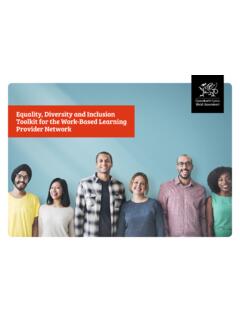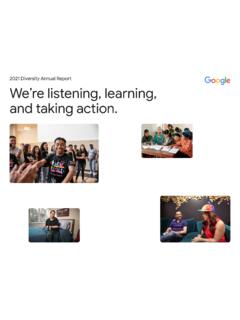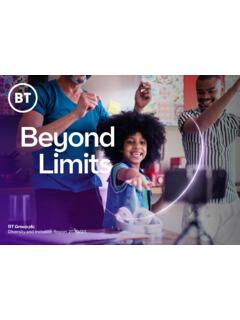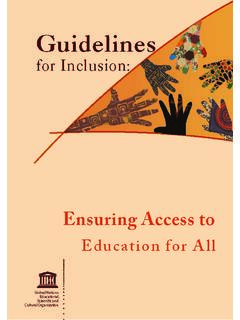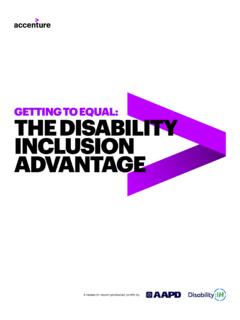Transcription of Effect of Availability of Teaching and Learning Resources ...
1 Journal of Education and Practice ISSN 2222-1735 (Paper) ISSN 2222-288X (Online) , , 2015 132 Effect of Availability of Teaching and Learning Resources on the Implementation of Inclusive Education in Pre-School Centers in Nyamira North Sub-County, Nyamira County, Kenya. Rachel Bosibori Okongo1,Dr Gladys Ngao2, Naftal K. Rop3, Wesonga Justus Nyongesa4 Abstract Inclusive education is a process of adjusting the home, school and the larger community to accommodate persons with special needs. In respect to pre-school learners, it is a means by which centers accommodate all learners regardless of their physical, intellectual, social, emotional, linguistic challenges. UNICEF notes that some 150 million children with disabilities lack access to child care services, schools, recreation and other social services, and are likely to remain illiterate and untrained, ultimately unable to join the labor force.
2 Children with special needs are still perceived negatively by society. Most of the learners with special needs do not enroll in pre-school centers in Nyamira North Sub-county and if enrolled, they drop out before the year ends as per the report from Education Office. The study aimed at finding out whether Availability of Teaching and Learning Resources influenced implementation of inclusive education in pre-school Centers in Nyamira North sub-county. Efforts have been made to integrate the learners with special needs although the programme has encountered a lot of challenges; policies have been put in place to provide for the achievement of universal education and the realization of vision 2030. However, Inclusive education experiences a pyramid of challenges at pre- school level in the world and Kenya.
3 The study employed descriptive survey research design. The target population was 134 head teachers in 134 pre-school centers, 402 pre-school teachers, 12 Education officers and 938 pre-school parents in Nyamira North Sub-county. Sample size was 40 pre-school centers and 40 head teachers which were randomly sampled to represent 30% of the centers. Further, 134 pre- school teachers and 270 pre-school parents were sampled through stratified random sampling and 12 Education Officers sampled by census sampling. Data was collected using questionnaires and observation checklists. Descriptive statistics of means, percentages and weighted averages was used in analyzing the data. Findings revealed that there were inadequate Teaching and Learning Resources at pre-school centers in Nyamira North sub-county.
4 78 percent of the respondents revealed that inadequate Resources affected the implementation of inclusive education. The study recommends that adequate Teaching and Learning Resources should be provided to ensure effective implementation of inclusive education and more funds to be allocated for procuring Teaching and Learning materials for Special Needs Education (SNE) learners. Keywords: Inclusive education, Teaching and Learning Resources , pre-school centers, learners with special needs, implementation Background of the Study According to Owoko (2010), the term Resources refers not only to Teaching methods and materials but also the time available for instruction, the knowledge and skills of teachers acquired through training and experience. Teaching pupils with special needs in the inclusive classroom deviates from the regular programme.
5 Pupils with special needs may require more instruction time, other Learning methods and professional knowledge. This can be achieved by an increase in Resources or by re-arranging available Resources . Children with special needs are not required to meet the classroom standards rather the classroom meets the individual needs of all children (Bargsma, 2000). Puri and Abraham (2004) argues that school management and teachers should make efforts to identify and attend to learners with special Learning needs for instance dietary needs especially pre-school. Oyugi and Nyaga (2010) note that Teaching and Learning Resources include; peripatetic services, support staff (sign language interpreters and Braille transcribers), community involvement, regular and special teachers among others. Inadequate trained special education teachers and professional s acts as an obstacle to implementation of inclusive education (Kochung, 2011).
6 Oliver (1996) notes that the education system has failed learners with special needs by not equipping them with 1 Director ECDE and CCC, Nyamira County Government 2 Lecturer Maasai Mara university, school of education 3 Lecturer Maasai Mara University, School of Education 4 Lecturer , Maasai Mara University Journal of Education and Practice ISSN 2222-1735 (Paper) ISSN 2222-288X (Online) , , 2015 133 appropriate Teaching and Learning materials to exercise their rights and responsibilities as citizens, while the community and special education system has functioned to exclude them from both the education process and wider social life.
7 (Heward, 2003). Instructional methods, examination systems and rigid curriculum are some of the barriers to implementation of inclusive education in pre-school centres in Kenya. Implementing successful inclusive education often requires adequate support human resource, Teaching and Learning Resources . Teachers frequently feel there is lack of human Resources , Teaching and Learning facilities; this poses great barriers to implementing successful inclusion (Crawford, 2004). In Nyamira North Sub-county, there are 19 special units which specifically carters for 440 pupils who are challenged against 25 SNE teachers (SCDE, 2012). Smith and Sutherland (2006) explained that Availability of Teaching and Learning materials, resource centers attached to ordinary schools, teachers attitudes towards inclusion of children with special needs are most important for success or failure of implementing inclusive education.
8 Environments where education institutions are situated are not disability friendly and the facilities within the community are inaccessible. Statement of the Problem Children with special needs are perceived negatively by society; in that, most learners do not enroll in pre-school centers since they are neglected group whose value to economic development is minimal or not existing. Therefore, using Resources on them is like doing a lot of wastage without the realization that Disability is not inability . Several factors have been identified to affect the implementation of Inclusive education in pre-school centers, these include limited Resources and poor implementation strategies ( Fullan 2003). This study therefore, sought to examine influence of Teaching and Learning materials for the implementation of Inclusive education in Nyamira North Sub-county.
9 LITERATURE REVIEW Educational inclusion Inclusive education is more than mainstreaming. Mainstreaming implies that a student from a separate special education class visits the regular classroom for specific, usually non-academic, subjects. inclusion is an educational process by which all students, including those with disabilities, are educated together for all, or at least most , of the school day. Generally 80% or more of the day is what is considered inclusion by proponents-a majority could be anything more than 50%. With sufficient support, students participate in age-appropriate, general education classes in their neighborhood schools. inclusion is a philosophy of education based on the belief in every person's inherent right to fully participate in society. inclusion implies acceptance of differences.
10 It makes room for the person who would otherwise be excluded from the educational experiences that are fundamental to every student's development. When inclusion is effectively implemented, research has demonstrated academic and social benefits for all students: both those who have special needs as well as typical students. Friendships develop, nondisabled students are more appreciative of differences and students with disabilities are more motivated. True acceptance of diversity ultimately develops within the school environment and is then carried into the home, workplace and community Elweke and Rodda, 2002; Stough, 2003. Benefits of inclusion A number of studies over the years have reported the various benefits of inclusive education. In 1996, the National Down Syndrome Society published a research report on the inclusion of children with Down syndrome in general education classes.










